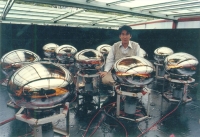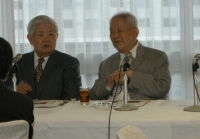 |
 |
|||||||||||||
|
|||||||||||||
|
|||||||||||||
|
During the eighth workshop of the “Federation of Diet members to promote the realisation of ILC” held at Nagatacho, Tokyo on 26 April, there was a lecture that provided a good feeling of the “Yara-maika” spirit.
“Yara-maika” is a word in a dialect from the west part of Shizuoka Prefecture, Japan, and means “Let's try, why not?” It demonstrates the challenging spirit hammered into the people living around that area to support the way enterprises and the inventors attempt to achieve difficult goals. Hamamatsu city, which is located in the western part of Shizuoka, is also known as the birth place of the first full-scale Japanese organ in 1888, and the home of Honda, Suzuki and Yamaha: the Big Three who dominate the current world motorcycle market. Moreover, Kenjiro Takayanagi, the father of television technology, was born in Hamamatsu. He was a teacher at Hamamatsu Technical High School at the time when he successfully transmitted and received an image on a cathode ray tube for the first time in the world. The workshop started with a keynote address by Masatoshi Koshiba, Nobel Prize winner for Physics in 2002, followed by a lecture by Teruo Hiruma, President of Hamamatsu Photonics K.K., the company founded in 1953 by Heihachiro Horiuchi, who was at that time a student in Takayanagi's seminar. Hamamatsu Photonics is widely known for developing the world's largest photomultiplier for Kamiokande, jointly with Koshiba's study group. Kamiokande consists of a huge tank which holds 3000 tons of ultrapure water equipped with an array of 1000 photomultipliers installed on its inner wall, 1000 metres underground, in the Kamioka mine in the Gifu Prefecture, Japan. These photomultipliers measure 50 centimetres in diameter, which explains the technical difficulty to develop such detectors. (Commonly used photomultipliers measure only 12.5 centimetres in diameter.) It took Koshiba three years to persuade Hiruma to agree to jointly develop the impossibly big photomultipliers. Once R&D started, they completed development in less than one year, and the 'huge eyes' caught sight of neutrinos from the Magellanic Clouds caused by the supernova SN 1987A on 23 February 1987, only one month after installation. “I often use the word 'Yareba-dekiru (Do, and it will be done)' and people in Hamamatsu use 'Yara-maika'. I found that both of us were thinking the same way,” said Koshiba. He is recognised for having established the new field of “Neutrino Astronomy” as a result of the research conducted at Kamiokande, an achievement that has only been possible thanks to their challenging spirit. As president of the company which has a 60 percent share of the worldwide photodetector market, Hiruma is a specialist of light. “Light is what nestles deeply in the molecules that make up matter, and makes it possible for matter to be what it is. Although its roots extend deeply into the origins of the world we live in, there's still much that we don't know about light. We believe that light, and thus photonics, holds the key to creating new industries in the future,” he said. Hamamatsu Photonics is now focusing on the ILC, participating in numerous R&D endeavours related to the global project, such as the Multi-Pixel Photon Counter (MPPC) for calorimeters (see NewsLine 19 April 2007 and 20 July 2006 that they developed together with Shinshu University and Tsukuba University, Japan. “Some people say that something is impossible because they are short of money. But I don't think that is true. They just don't have ideas or creativity,” said Hiruma. “You never find out that something is impossible without trying to do it. Even if you find out that it is impossible, you will know the reason why. We need to keep trying to discover new knowledge.” The Hamamatsu spirit of “Yara-maika” is said to have grown in peoples' minds during the turning point of Japanese history: the Meiji era, when Japan opened the country to western culture after 300 years of national seclusion. Now, the world science and technology is standing at a crossroads. “The ILC will change the industrial world dramatically,” said Hiruma. The challenging spirit and passion for paving the way into the unknown will be a key for future science. -- Rika Takahashi |
|||||||||||||
| © International Linear Collider |

